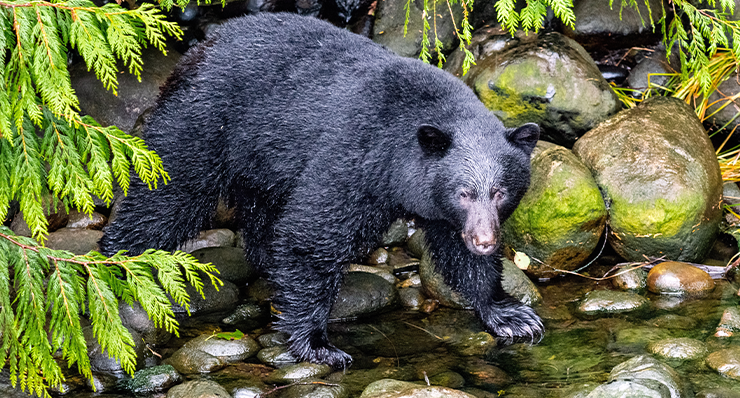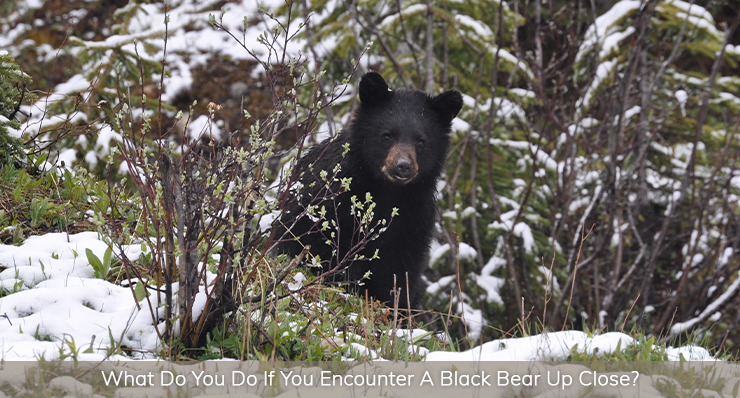CHECK OUT OUR VACATION RENTAL SPECIALS
 VIEW SPECIALS
VIEW SPECIALS

Wildlife is one of the many draws that bring people to the North Carolina mountains. Our state is known as bear country. We are fortunate enough to be home to black bears and thousands of visitors travel through the mountains each year in the hopes of seeing at least one. Before you visit the mountains, there are some bear safety tips you should know. We’ll also tell you how to spot a bear and how to safeguard yourself and your belongings against them.
First thing is first: You need to know what kinds of bears you’ll be dealing with in North Carolina. North Carolina is only home to black bears, one of the three types of bears found in North America. Black bears stand between 5-6 feet tall, have tall, narrow ears that stand at attention, and lack the shoulder hump that grizzlies have. One myth about black bears is that they can be identified by their black coat alone, but that’s not necessarily the case. Black bears can have brown coats, or even white patches. Some rare black bears sport a coat that’s more “blue” in color. Typically, black bears are quite a bit smaller in size than grizzlies, but again, this isn’t always the case.
Fortunately, you can be sure that the only bears you are dealing with in Western North Carolina are black bears.
The most likely place you’ll run into a bear is in the woods while hiking. Though black bear attacks are truly rare, you’ll want to start off your hike with bear safety tips in mind before you hit the trail:
The more people, the better. There is safety in numbers. A black bear will be much more likely to hear you from a distance, and change their direction to avoid you and your group.
If the thought of running into a bear makes you nervous, go ahead and spend the extra money and invest in some bear spray. Many brands can spray up to 20-30 feet, ensuring a safe distance between you and a bear. However, you should only use the bear spray if you feel the bear is getting too close and starting to act aggressively. If the bear is walking a safe distance from you, and isn’t coming in your direction, you should allow the bear to go on its way and respect its space if it isn’t interested in you.
This seems obvious to us, but we should reiterate to never approach a bear or offer it any of your food. It will only make a bear attack more likely. All bears are beautiful, amazing creatures and you are protecting both yourself and them by observing them from a distance.

This is a delicate, rare situation. Most of the time, when you see bears in the mountains, it’s from a safe distance. But let’s say you and your loved ones run into a black bear on the trail, and the bear has noticed you and isn’t running away. Fortunately for us, black bears are not aggressive in nature. Remember that they are naturally more scared of you than you are of them. Here are some bear safety tips if you run into a bear:
Are there cubs with the bear? Is the bear standing next to another animal carcass they’ve claimed as food? All bears will behave more aggressively than normal if they are defending their young or their food. Once you note this, you can better assess the situation.
If the bear hasn’t quite noticed you yet, or if it’s staring you down, speak to the bear in a calm, firm voice. If it hasn’t noticed you, this will alert the bear to your presence so it isn’t startled. This will also let the bear know you are not intending to be aggressive, and you are not prey, either. If you have bear spray, have it ready with the safety turned off. Most bears at this point wilI decide to run or walk away. If they do, stay put until the bear is out of sight, and then do not go in the direction the bear has gone, even if it means going back the way you came.
If the black bear is displaying defensive behaviors, continue to remain calm, speak in a low tone, and continue to back away slowly, increasing the distance between you and the bear. The bear is trying to tell you that you are too close for comfort, and it will likely walk away once it sees you are increasing the distance. If a bear stands on its hind legs and is simply peering out and sniffing at you, this isn’t necessarily an aggressive behavior. This is the bear being curious about you. It’s what the bear does after this behavior that will be clear as to whether or not it isn’t interested in you, or it sees you as a threat.
It’s important to read the situation as best you can with a bear. Knowing black bear behaviors can save your life and make a possible encounter easy and peaceful.
This is extraordinarily rare, but there is a small chance that this could happen, especially if you misread a black bear’s behavior. The very few black bear attacks on humans are known to be mama bears with cubs.
If escape is not possible, and a black bear approaches or charges you, and you don’t have bear spray, you should make yourself look as large as possible. Yell as loudly as you can and wave around any objects you may have in your hands (like a walking stick or hiking pole, for example). Making yourself as loud and large as possible will likely intimidate the bear and make it retreat. If the black bear makes contact with you, do your best to hit in in the muzzle and eyes.
The important thing to remember is that you are not dealing with grizzly bears, so while you would be instructed to play dead when encountering a grizzly bear, you should NEVER play dead with a black bear. It will only make things worse for you. You should also not resort to climb a tree, as bears can swiftly follow you up the trunk.
Black bear attacks are extremely rare if practical bear safety tips are put to use from the start of your hike, or a visit to the North Carolina mountains. The chances of you having to put this fighting strategy to use, even if you have a close encounter, are slim.
Many of our Landmark vacation rentals are tucked into the woods, so it’s possible you might run into a black bear. But don’t panic! Observing a bear from the safety of your vacation rental is the safest place to see one, and you can just quietly observe these beautiful animals in the wild from your window. If you ask any of our brokers and staff about their bear experiences, almost everyone can fondly remember the first time they saw one, and it’s typically a neat experience for everyone. Locals get just as excited to spot one as visitors!
If the possibility of seeing a black bear excites you, get in touch with us today, and we can share with you more bear safety tips, and where you might be able to view them in the mountains. On your next vacation, we can put you in one of our Landmark cabins and you can watch for bears from the comfort of your covered porch swing. Let us help you experience the mountains like we do.
0 COMMENTS